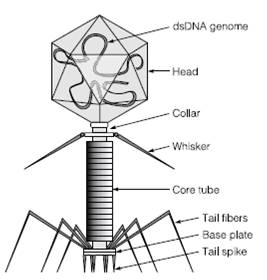Viruses of bacteria
In common with most living organisms, microorganisms can be infected by viruses. The virology of higher organisms is discussed further in Section K. The viruses that infect the Bacteria and Archaea are the bacteriophages, sometimes abbreviated to phages. Bacteriophages are not living entities and are incapable of reproduction outside of their host cell. In essence they are genetic elements that have acquired the ability to maintain themselves outside the host cell by coating their nucleic acids with proteins, but are no more alive than the protein-free DNA of plasmids, transposons or insertion sequences .As with the viruses of eukaryotes, the form and reproductive cycle of bacteriophages varies considerably. The extracellular virion form can be filamentous (e.g. bacteriophage M13), icosahedral (e.g. bacteriophage T4, but see Section K1 for a fur- ther discussion of icosahedral symmetry) or have a distinct head and tail section. Some bacteriophages are surrounded by a membrane, which is often derived from the host. The diversity of shapes of the protein part of the virus is accompanied by a diversity of nucleic acid complements. Most possible variations of nucleic acid content – dsDNA, ssDNA, dsRNA, ssRNA – have been observed in bacteriophages. Almost all species of Bac- teria and Archaea have been found to have one or more bacteriophage that infects them, and some phages have an extremely broad host range.

All bacteriophages have common methods of replication. Attachment to the host cell is followed by entry to the cytoplasm by penetration or injection. Phage gene expression commences and the phage genome is copied. Genomes and phage proteins are then assembled into virions ready for release and to begin the infection cycle again. An archetypal bacteriophage has a head containing the genome, and a tail to attach to the